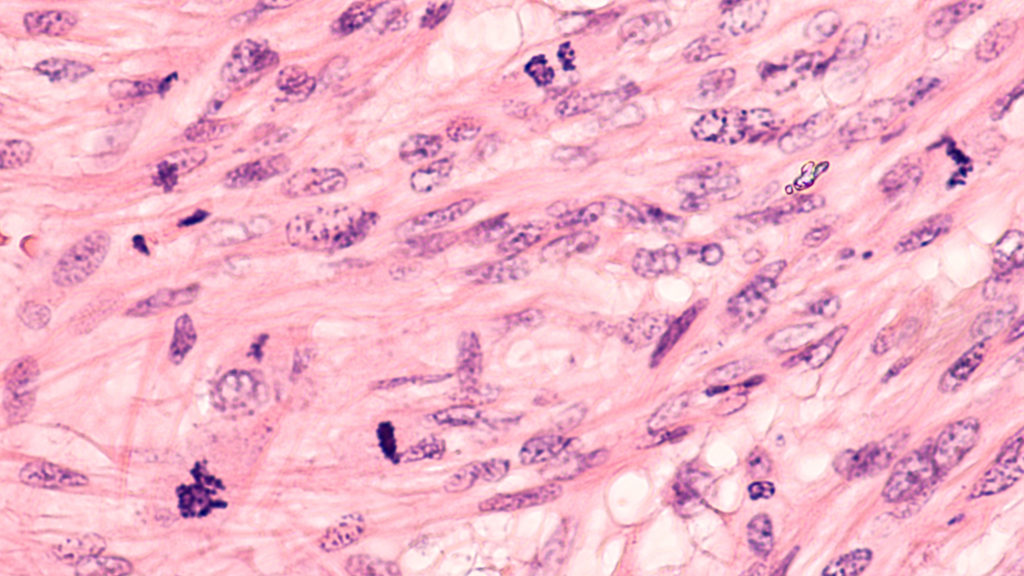Researchers examined five potential prognostic and therapeutic biomarkers across 18 different histologic subtypes of sarcoma in 163 tissue samples.

Today, the average five-year survival rate for patients with metastatic sarcoma (malignant mesenchymal neoplasms of the bone or soft tissue) is a mere 15%. Over 50 histological subtypes of sarcoma have been identified, each with unique clinical behaviors. To help predict these clinical behaviors in patients with various sarcomas, physicians use currently available grading schemes. However, the available grading schemes are inadequate in a large subset of sarcomas.
“Although the French (FNCLCC) and NCI grading schemes have been adopted for many sarcomas [2, 3], there is a substantial subset of sarcomas for which the grading scheme does not adequately predict clinical behavior.”
Thus, researchers from the University of Iowa, University of Alabama at Birmingham, and the Mayo Clinic report the need for additional prognostic and therapeutic biomarkers to predict clinical behavior across different histological types of sarcoma. Their recent study was chosen as the cover paper of Onoctarget’s Volume 12, Issue #8, and titled: “Prognostic and therapeutic value of the Hippo pathway, RABL6A, and p53-MDM2 axes in sarcomas.”
Immunohistochemical Staining
This team identified five proteins as candidate biomarkers for sarcoma, which were based on a number of previously reported implications in various human cancers:
“TAZ/YAP were shown to be activated in multiple histological types of sarcoma [11–13].”
“Alterations of the p53 pathway are among the most frequent aberrations observed in human cancers, including sarcomas [20, 21]. p53 appears to be an essential player in sarcomagenesis.”
“MDM2 is part of a p53-MDM2 axis known to play a key role in several sarcomas.”
“RABL6A is a newly recognized oncoprotein that has been implicated in various human cancers, including pancreatic neuroendocrine tumors [35, 36], breast cancer [37, 38], colon cancer [37], non-small cell lung cancer [39, 40], pancreatic ductal adenocarcinomas [41] and osteosarcoma [42].”
The expression of TAZ, YAP, p53, MDM2, and RABL6A proteins were examined using immunohistochemical (IHC) staining among 18 different histologic subtypes of sarcoma from 163 tissue samples. Using statistical analysis to process the IHC staining results, they calculated H-scores (or “histo” scores—composed of the staining intensity multiplied by percent of positive cells) for each of the five proteins.
Statistical Analysis
Of the biomarkers examined, all five were positively associated with sarcoma tumor grade. Unadjusted univariate analysis showed that RABL6A protein expression had the strongest association with tumor grade. TAZ and YAP are both phosphorylated by LATS1/2 when the Hippo pathway is activated under normal circumstances. Researchers know that dysregulation of the Hippo pathway can lead to uncontrolled cell growth or neoplasia. Complementary, yet distinct, results across multiple histological types of sarcomas showed that elevated expression of YAP better predicted worse overall survival rates, and elevated TAZ better predicted worse progression-free survival rates.
“Importantly, YAP and TAZ expression did not entirely mirror one another, suggesting differences in their regulation.”
They also found that, in the absence of p53 expression, the combined expression of TAZ and YAP adversely affected the overall, progression-free, and metastasis-free survival more so than TAZ or YAP alone. The authors explain that additional research is needed to determine how the inactivation of p53 cooperates with elevated TAZ and YAP expression in sarcoma tumor progression.
“TAZ and YAP were prognostically important in p53 null but not p53 high (mutant) sarcomas with regards to overall survival, progression free survival, and metastasis free survival. These data suggest that TAZ and YAP may cooperate with loss of p53 expression in some contexts to drive sarcomagenesis.”
Correlation-Based Network Analysis
The researchers conducted correlation-based network analysis and showed that YAP is indirectly linked to p53 via RABL6A (which is known to drive MDM2 activity), while TAZ and MDM2 are also positively correlated. The researchers explain this indicates that both nuclear effectors of the Hippo pathway interact with the p53-MDM2 axis.
“Because RABL6A functionally interacts with p53 and MDM2 [34], we hypothesized it may connect the different signaling axes.”
“Here, the discovery that RABL6A expression correlates with dysregulated p53 and YAP across diverse sarcoma types suggests a key role for RABL6A in promoting the pathogenesis of other sarcomas. Additional studies determining the mechanisms by which RABL6A regulates the activity of YAP and p53 in sarcomas are warranted.”
Conclusion
“The interrelated RABL6A/YAP/p53 and TAZ/MDM2 network provides multiple opportunities for therapeutic intervention.”
Findings from this study suggest that there are both independent and cooperative roles for all five biomarkers across different histological types of sarcoma. Expression levels of these proteins can be used to predict patient outcomes and potentially to guide future therapeutic approaches. The researchers note that additional studies must be carried out in larger samples to further validate the protein expression signatures found in this study.
“Furthermore, there is a need to further validate these RABL6A/YAP/p53 and TAZ/MDM2 expression signatures in larger numbers of different histological types of sarcoma to determine if it differentially predicts prognosis or response to therapy within individual subsets of these sarcomas.”
Click here to read the full scientific study, published in Oncotarget.
—
Oncotarget is a unique platform designed to house scientific studies in a journal format that is available for anyone to read—without a paywall making access more difficult. This means information that has the potential to benefit our societies from the inside out can be shared with friends, neighbors, colleagues, and other researchers, far and wide.

For media inquiries, please contact media@impactjournals.com.



